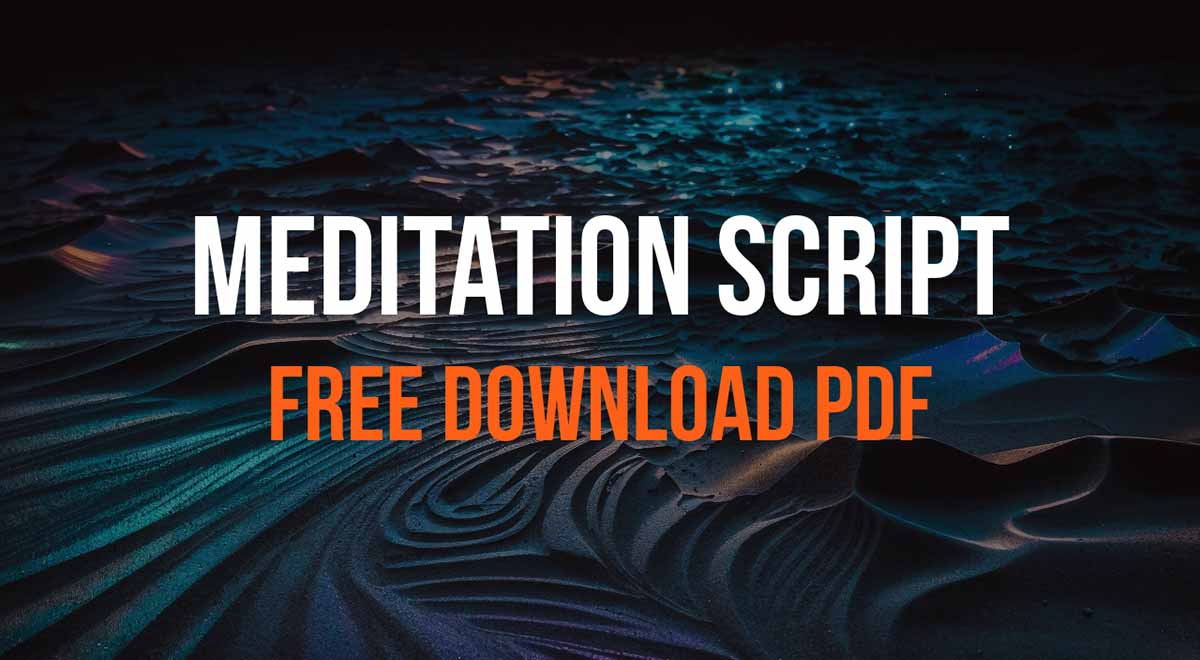Guiding a meditation script requires planning and practicing.
Whether you’re leading a meditation session in person or recording a guided meditation for others to use, here’s a step-by-step guide on how to create and deliver an effective guided meditation.
Keep reading!
Step 1: Define Your Purpose
Before you begin, determine the goal or intention of your meditation.
Are you guiding relaxation, stress relief, mindfulness, self-compassion, or something else?
Clearly defining the purpose will help you shape your guided meditation’s content and speaking style.
Step 2: Choose a Comfortable Environment

Find a quiet and comfortable space with minimal distractions.
Ensure good lighting and acoustics if you plan to record a video of your meditation.
Step 3: Prepare Your Script
Write a clear and concise meditation script that aligns with your purpose. Keep it simple and easy to follow.
Use positive and affirming language. Avoid negative or judgmental words.
Make sure to include relaxation techniques, breathing exercises, and visualizations relevant to your meditation goal.
Use descriptive and vivid imagery to engage the listener’s senses.
Structure your script with an introduction, body, and conclusion. Start with a brief explanation of the meditation’s purpose, guide through the meditation, and end with a gentle transition back to the present moment.
Learn more how to write a compelling meditation script.
Browse hundreds ready-to-use guided meditation scripts for commercial use.
Step 4: Practice Your Delivery
Familiarize yourself with your script to ensure a smooth and natural delivery before you perform or record your meditation session.
Practice speaking slowly and clearly. Use a soothing and calm tone of voice throughout.
Record yourself to assess your pacing and delivery. Make adjustments as needed.
Learn how to record guided meditations with free software.
Step 5: Guide the Meditation
If you’re not using a prepared script, remember:
Begin with a brief introduction, explaining the purpose and benefits of the meditation.
Instruct participants or listeners to find a comfortable seated or lying position.
Guide participants through a relaxation phase, often starting from the toes and moving upward, encouraging them to release tension in each body part.
Incorporate breathing exercises to help participants relax and center themselves.
Use visualization techniques to guide participants through the meditation’s main theme or goal.
Provide pauses for participants to explore their inner experiences, thoughts, and sensations.
Maintain a gentle and soothing tone, reassuring participants and encouraging them to stay present.
Step 6: Concluding the Meditation
If the script you’re using does not offer this, gradually bring participants or listeners back to the present moment, starting from the toes and moving upward, awakening each body part.
Offer gratitude and encouragement for their meditation practice.
Provide guidance on transitioning back into their day or night.
End with a calming statement or affirmation or (if you’re ending with a pause) a specific sound that indicates the end of the session.
You can use sounds like these:
Need music for a future project?
Step 7: Encourage Self-Reflection

Once the meditation is completed, encourage participants or listeners to reflect on their experience.
You can ask open-ended questions or provide journaling prompts.
Step 8: Gather Feedback
This is important, yet often overlooked!
Whenever possible, gather feedback from participants to improve your guided meditations in the future.
Use relaxing or healing music to amplify the effect of your guided meditation
Music helps to set the mood from the beginning and fills the awkward silence if you have pauses in your meditation.
When choosing background music look for ambient meditative music without prominent lead melody.
The purpose of background music is to set the mood without taking attention away from your voice over.
Here are some examples of music and sounds that work well in background of guided meditations:
Listen to our playlist of music for guided meditations.
Looking for more relaxing meditative music and sounds?
Possible next steps
Now, when your guided meditation is completed (hopefully with relaxing music and sounds), think how you can use it.
When offering in person classes, you can either charge admission or rely on sales of related products, like books, recorded meditations, and more.
Speaking of recorded meditations, there are plenty more options to monetize it.
Learn how to monetize guided meditations.
If you’re focusing solely on YouTube read about how to make money with guided meditations on YouTube.
Conclusion
Guiding a meditation script that truly works requires careful planning and some practice.
Remember that your presence and demeanor play a crucial role in guiding a successful meditation.
Be patient, compassionate, and mindful of the needs of your participants or listeners.
With practice, you can refine your skills and create powerful meditation experiences for others.
Questions or comments?
Need help with guiding your first meditation script? Feel free to post your questions in the comments section below.
Download 12,000+ Royalty Free Music Tracks And Sound FX
Unlimited download | Lifetime license | Commercial use









